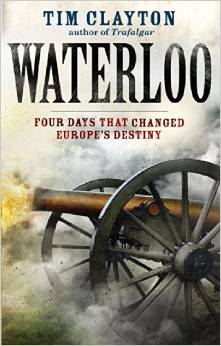Waterloo: Four days that changed Europe’s destiny by Tim Clayton
The impending 200th anniversary of the battle of Waterloo has seen a mini-burst of books coming out, of which Tim Clayton’s has been one of the best in reviews so far. It certainly deserves those reviews and comes with the triple bonus of a good set of illustrations, maps that are (all too rarely for history books) pitched at the right level of detail to be useful without being confusing, and enough references to allow the reader to follow up any aspects of the story that really catches their attention.
 Despite the subtitle, “Four days that changed Europe’s destiny” the book gives only relatively brief attention to the wider context of the battle, and in doing so assumes that it was necessarily important – as opposed to the counter-argument that given the relative strengths of France and the alliance Napoleon faced, he was bound to lose the campaign of 1815 even if he had won the first major battle. It’s a shame that Clayton didn’t explore this question in more detail given how skillfully he handles many other debates over the battle, such as the relative credit which is due to Wellington and to Blucher.
Despite the subtitle, “Four days that changed Europe’s destiny” the book gives only relatively brief attention to the wider context of the battle, and in doing so assumes that it was necessarily important – as opposed to the counter-argument that given the relative strengths of France and the alliance Napoleon faced, he was bound to lose the campaign of 1815 even if he had won the first major battle. It’s a shame that Clayton didn’t explore this question in more detail given how skillfully he handles many other debates over the battle, such as the relative credit which is due to Wellington and to Blucher.
It’s not only those debates he handles skillfully for the narrative of the two days of battle at the heart of the book is brilliant, weaving in detailed personal accounts with a broader explanation of which troops were headed where and with what significance.
Though the detail is a little mesmerising at times (I don’t think I’ve had as many detailed accounts of the sizes of gardens even when watching gardening programs), the significance of the detail is always explained clearly – as is the key role played by the fog of war, both with Wellington’s initial grievous failure of intelligence omitting to spot Napoleon’s invasion of Belgium and then later the confusion between Napoleon’s commanders resulting in his troops often being in the wrong place at the wrong time.
Unglamorous but vital staff work in trying to get soldiers into vaguely sensible locations at roughly relevant times was crucial – as was then the ability to identify whether approach troops were your allies or enemies. Death by friendly fire abounded.
As someone with a half-decent knowledge of the battle before reading the book, three details struck me particularly. First, how much is still unknown about the detailed facts of the events despite the huge volume of literature about the battle.
Second, the way cannon balls were fired. Perhaps I’ve relied too much on film and TV for my knowledge of warfare in the time of cannons, but I had completely missed that it was usual for cannons to bounce along like a Barnes Wallis bomb on land – and that this was a deliberate technique for a bouncing cannon ball could cause far more carnage than one which simply ploughed into one target and stopped. Perhaps in pre-CGI days it was too hard to show bouncing bombs in fiction and reconstruction – and hence the abiding visual image of cannons being fired is one that is wrong.
Third, for all the glorious place that Waterloo acquired in British history, it was horrendously gruesome with a density of killing that exceeded that of the Somme in 1916. That comparison really brings home quite what lies behind the bald death and injury statistics.
It makes for a sobering as well as illuminating read.
If you like this, you might also be interested in The Enemy at the Gate: Habsburgs, Ottomans and the Battle for Europe.
Got a view on this review? Then please rate it on Amazon.
Buy Waterloo: Four days that changed Europe’s destiny by Tim Clayton here.
Leave a Reply